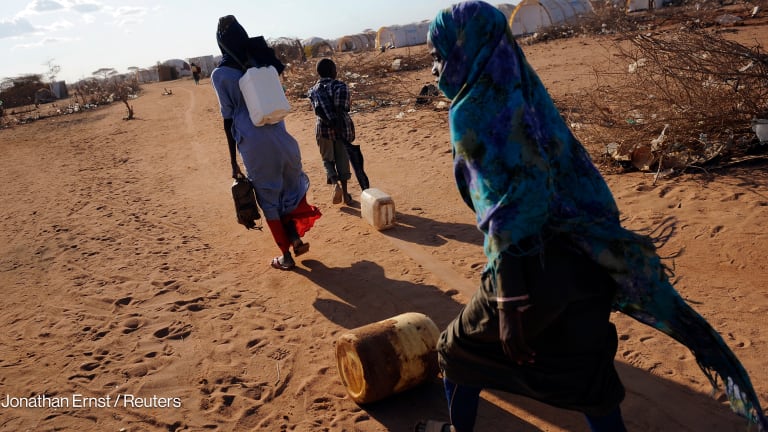
ALICANTE, Spain — As the coronavirus spread across the world, access to water emerged as a critical tool in halting it, allowing people to clean surfaces and wash their hands regularly.
In a bid to ensure citizens had access to the water they needed, some governments ordered utilities to provide it for free or at discounted rates. But those utilities are now struggling, and without support, progress previously made in water access could be undone, experts say.
In Africa, 11 governments pledged various forms of free or discounted water, deferred the payment of bills, or suspended any disconnection of water supply. The Democratic Republic of the Congo opted to make water free for two months, Ghana said it would absorb the nation’s water bills for three months, and Kenya moved to supply water to vulnerable communities and informal settlements for free. Elsewhere, governments from Bahrain to Bolivia and Togo to Thailand followed suit.
What does a COVID-19 response look like with limited water?
Much of what is needed in the COVID-19 response includes programming the WASH sector already has in place, but WASH professionals need to reenvision their strategies — and to do it quickly.
Several months on, the consequences of those well-intentioned mandates are now being felt. The suspension of water billing has led to a loss of revenue for utilities, while providing extra water has increased costs, according to Jennifer Sara, the World Bank’s global director for water.
“Water utilities face threats on multiple fronts as they aim to keep water flowing during the COVID-19 pandemic, while the outbreak places substantial stresses upon them,” Sara wrote in an email.
According to initial information provided by the World Bank, some revenue collection rates have fallen by 40 percentage points.
“What we have is a lot of potentially uncollectable debt being created ... and no real plan to get those costs [back] — besides government aid or the raising of rates — which would then compound the problems for the poorest,” said Luke Wilson, deputy director of The Center for Water Security and Cooperation, in an email. “Long story short, the utilities are being forced to take on debt by the government, but the people may not be able to repay it and the government may not be able to backstop the utility. We're walking a knife's edge.”
The consequences could be dramatic. “In the worst and most unfortunate case, you’d have utilities unable to maintain the operational costs, and as a first step, some utilities might want to reduce their staffing base to cope. Then they might want to stop paying electricity bills,” said Eden Mati Mwangi, acting country program manager for Kenya at Water & Sanitation for the Urban Poor.
If water services were affected, it could mean spikes in coronavirus outbreaks, particularly in high-density communities where social distancing is not possible, Sara said, while Wilson warned of “dirtier water, sicker people — from more than COVID — demonstrations, and civil unrest.”
At the start of the pandemic, Sanitation and Water for All called for policymakers to “financially support utilities to guarantee the sustainability of services,” even where tariffs had been waived as part of the COVID-19 response. While payments of deferred amounts, government transfers, and tariff adjustments are expected to compensate for the deficits in some markets, utilities elsewhere continue to wait for help.
In Kenya, Mwangi said the deficit is as high as 50% — based on data WSUP has collected from utilities in the major cities — and so far the government has yet to help cover the losses or signal whether the provision of water services will be extended. Consequently, some of the 88 Kenyan water utilities are already starting to disconnect those unable to pay their bills.
Over the longer term, some worry that the decisions made in the early part of the COVID-19 response to increase access to cheap or free water could backfire — not only because utilities could fail, but also because providing free water could mean people are less willing to pay later on, especially if financial stresses mean the quality of the service provision falls. That, in turn, could jeopardize efforts to achieve Sustainable Development Goal 6 on access to clean water for all.
“Utilities are being forced to take on debt by the government, but the people may not be able to repay it and the government may not be able to backstop the utility. We're walking a knife's edge.”
— Luke Wilson, deputy director, The Center for Water Security and Cooperation“This directive eroded all the gains we had made in championing successful marketing models in utilities where water is deemed as a basic right, but as a good that needs to be paid for,” Mwangi said. “Now we have a bigger challenge in bringing the sector back to where we were, where there’s demand for formal services from water service providers and there’s a willingness to pay,” she said.
Sara also warned that the deterioration of the culture of paying for water services could contribute to a “backsliding [of] the gains on sustainability of water supply and sanitation services” already made.
Supporting utilities
While countries may eventually step up and fill the revenue gap, there are actions that donors and nongovernmental organizations can take to support utilities in the meantime.
“Quantifying the financial impact of the pandemic on utilities operations is a vital first step,” Sara said. Regular data collection will help service providers project the financial impact on their operations in the coming months and prepare accordingly. The World Bank and its multidonor trust fund, the Global Water Security & Sanitation Partnership, have developed a tool that looks at revenue, debt, operational expenditures, and additional costs to help utilities do this.
More data can help make the case for funding. In Kenya, Mwangi said $10 million is needed to support the country’s utilities. Such funding could come from central governments, multilateral development banks, or other donors.
GWSP has put together recommendations for policymakers on how to design their own financial facilities to provide emergency support to water utilities. These include estimating the emergency financing needs before finding a source of funding — either through the government, an official financier, or commercial borrowing — and creating a set of disbursement rules.
Other ways of supporting water availability could also alleviate the pressure on utilities, according to a paper prepared for the U.K. Department for International Development.
Those include subsidizing the price of water from communal access points — which makes it cheaper for residents than household tariffs but allows the utility to still generate revenue — working with private sector providers to fill gaps in service provision, and offering prepay solutions such as smart cards, vouchers, and tokens. These allow a greater level of control around spending on water while enabling utilities to earn.
In the future, there has to be a better way to deal with water access than providing free water, according to Mwangi.
“The benefit of this situation is that now that we've seen what is required during a pandemic, governments should have a better sense as to how to address these issues and to prepare in advance,” Wilson said. "You might even see a new industry of ‘pandemic insurance’ for governments and utilities arise based on this, where payouts occur when there is a pandemic that helps cover costs.”
In the meantime, if relief is not provided, Sara said to expect deterioration of services, a backlog of rehabilitation, staff losses, and potential spikes in coronavirus outbreaks.
When asked if there is the potential for insolvencies, Wilson said yes. “And I would say that bond defaults, foreclosures, and deepening poverty are not far behind.”









